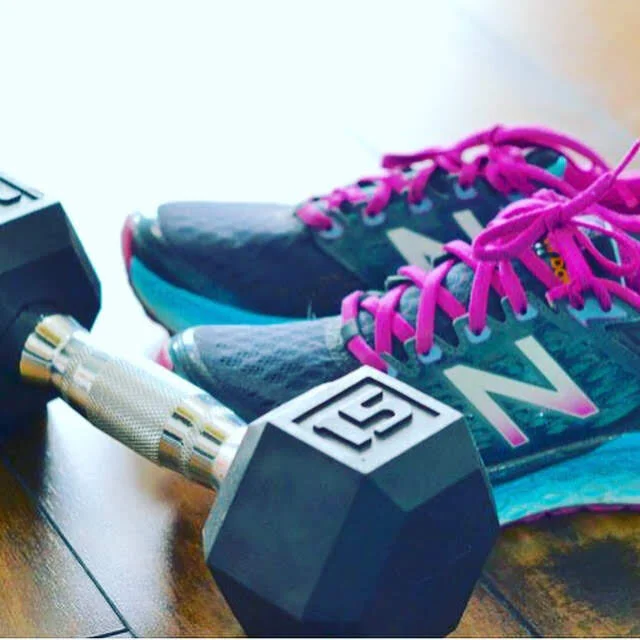It's my life mission to get weights in the hands of every runner. Why? Because the benefits of resistance training pay off in running performance, injury prevention, body composition, mental strength, and confidence!
I know what you are thinking. Don't you know I am already running (insert number of) hours a week? I have a family, career, a social life; How will I find the time? The good news is that it doesn't take six hours a week in the gym to see benefits, and you don't have to stop running to make time!
You don't have to overhaul your whole workout routine; you can add some new exercises to your warmup to get started. In fact, it is better that you don't jump in and create a new hour-long strength workout from the get-go. That will surely leave you sore, tired and may dissuade you from continuing. Instead, let's ease into it!
There's no downside to starting small. Do a little strength training now, be consistent with it, and as you grow stronger and begin to see some of the benefits, you can add more later. It is the best path forward for a runner new to strength training.
How to fit strength training into your running routine:
Do a few strengthening exercises before running to serve as a warmup. The idea here is not to exhaust yourself pre-run but to increase blood flow, loosen up stiff joints, and get those muscles ready to run!
Do some strengthing exercises for 15-20 minutes after running. You could do it immediately after or during a different part of the day. I often run in the morning and do some strength training at lunch.
Do some strength training exercises on your days off from running. Be sure to give yourself at least one or two full rest days from moderate to intense activity per week. Rest and recovery days are part of the training plan.
As you progress, how you fit in strength training may change. You may start with low-intensity exercises as a warmup before running, but as you get stronger and want to add more weight, you may find it better to do it later in the day on the same day as a run. There is no right or wrong way, only what works best for your preferences, your schedule, and your ability to stay consistent.
The way runners need to strength train to see the benefits play out in performance is different from a bodybuilder's. So to get the maximum results from the time you spend strength training, be sure you are following a runner-specific strengthening program.
What does runner-specific strength mean?
Strengthening the muscles that are used to run
Single-leg exercises to build independent leg, hip, and ankle strength and balance, and stability
Multi-planar exercises, which means moving in all three planes of motion to avoid the imbalances that can occur when running is the only exercise you do
Exercises that improve posture for the back and shoulders that help you maintain proper running form over longer distances
Core strengthening exercises
It means we are not wasting time and energy on exercises that don't directly benefit our running performance. Of course, there are some carry-over benefits from doing almost any strengthing exercises. Still, if we are time-crunched and want to get the most out of our time in the gym, we don't spend a lot of time on isolation exercises like bicep curls and lateral raises. (There's nothing wrong with these exercises if you want more muscular, shapely arms, but for now, we are talking about the exercises that directly improve running performance.)
Three Strength Exercises That Every Runner Should Do
I put together three exercises that would benefit every runner, but I definitely cheated because I couldn't narrow it down to just three, so I combined a few moves into each exercise to get more benefit in less time.
I am using a medicine ball, which is excellent if you have one available, but you can also perform these moves with dumbells or no weights if you are getting started. Try gripping a single dumbbell on each end so that you’re holding one dumbbell with two hands.
(If you are viewing this in an email, you may have to click through to the post to see the demonstrations of the exercises.)
Single-Leg Deadlift to Row to Overhead Press
Lateral Lunge to single-leg chest press
Lift & Chop
Start with 1-2 sets and 6-8 reps on each side or leg. Do all the sets for the first exercise, rest, then complete the sets for the second exercise, and so on. Once you have established good balance and stability, think about increasing the reps on each side, the number of sets, or the amount of weight you use for the exercises. The key to seeing continuing improvements that pay off in your running performance is to make it a bit harder as you get stronger in the moves.
Does this seem doable? My goal here is to provide simple, actionable workouts that you can do at home to help you become a better runner.
Try these on Instagram and tag me. I'd love to see you in action!
Did you like this post? Do you know someone who might benefit? It helps me when you share with your friends and followers on Facebook, Twitter, or Pinterest.
Questions? I’d love to help.













We love to blame the scale when we don’t like the number, but the truth is, the scale isn’t the problem—it’s how we think about it. In this post, I’m breaking down why focusing on the number keeps you stuck and how shifting your mindset around the scale can change everything about how you measure progress.